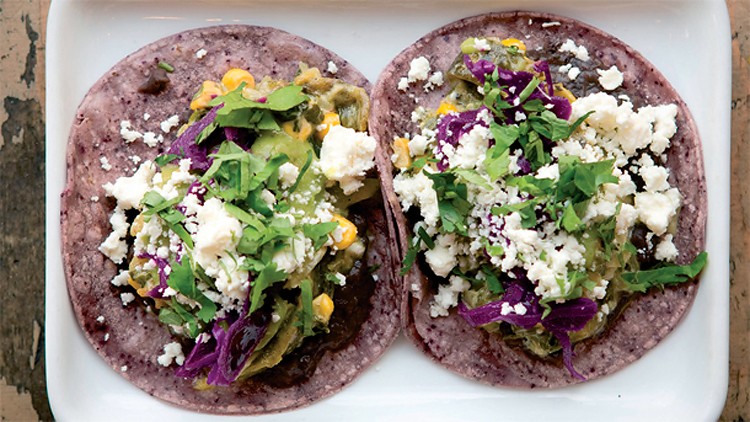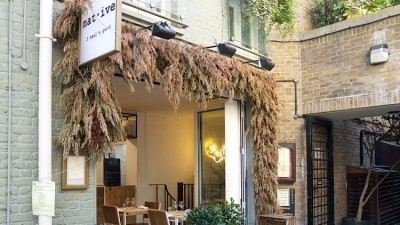Wheel of Misfortune: The nine biggest threats to the industry in 2018

David Fox, the owner of five Tampopo and East St restaurants in Manchester and London, predicts that 2018 heralds a perfect storm for the industry: “Several factors are aligning. That’s never happened before in our sector,” he says. “I’m a £6m-turnover business and I’ve had a £53,000 rates increase, a £70,000 hike in food costs, a £50,000 increase in my wage bill and have a rent review coming that’s potentially going up £120,000. Putting my prices up 4%, the largest rise in 15 years, I’m still going backwards.”
If, in 2017, the air was thick with warning rumbles of thunder (losses and closures at Jamie’s Italian; a rumoured cut-price sale of Byron; a raft of smaller operators in administration), 2018 is when the hard rain will fall. Seven of 10 leading UK restaurant brands saw operating margins by reported turnover drop in 2016, according to MCA’s Restaurant Market in 2017 report, and profit margins are expected to decrease through 2018. “Declining visit frequencies, rising costs and over-expansion are ushering in a challenging period,” says Simon Stenning, MCA’s executive director.
Yet many operators still back themselves to weather this storm. The Alchemist Group, for instance, is rolling out four or five new sites this year, the first in Nottingham this month. Paul Campbell, a serial restaurant investor via his Hill Capital Partners, urges calm: “This industry has a habit of becoming wildly optimistic then, suddenly, it’s all doom. The truth is always somewhere in the middle.”
In the East Midlands, John Molnar agrees the impact will vary city by city, street by street, concept by concept. The fight at his Moleface Pubs is, he says, “tough and getting tougher”. Yet he is about to open his third Cod’s Wallop chip shop restaurant: “It’s a different world. Overheads and staff costs are easier to control. Chip shops are neat. They make money.”
Despite the challenges, Fox remains confident good operators will thrive. “Dealing with the market is part of being in business. Shit happens,” he says. “We just have to get on with it. Fundamentally, it’s a growing market.” But it comes with a caveat.
“Those who don’t deliver the right concept in the right location are less likely to survive than five years ago.”
Threat: soaring property costs
The recent so-called ‘space race’ between restaurants has caused rental prices to spiral directly (as operators outbid one another for sites) and indirectly. Most rent reviews are based on open market value – that is, what other restaurants in an area pay – and so every time a VC-backed brand pays over the odds for a site, it forces up rents for everyone.
Sometimes, says Tampopo’s Fox, it makes more sense to get out than to keep paying rising rents: “We saw this coming. I came out of two sites in retail-leisure schemes in Bristol and Reading [in 2015] and got just shy of £1.1m as key money, to get out. That tells you what it would have cost to go in.”
Rents in London are the highest in the UK, and landlords have long argued the footfall in the capital and the average spend per head of a diner justifies the costs, but this is something restaurateurs have now begun to question.
“Twelve months ago you could have made a reasonable argument that London rents, if ridiculous, were efficient in an industry where the model is rent should be 8–10% of turnover,” says Hawksmoor co-founder Will Beckett. But since then he says that “rents have risen out
of all recognition” and, even as venues teeter on the precipice of a market correction, it may be 18 months before landlords feel its impact.
“I don’t think there are going to be any phenomenal bargains available anytime soon,” predicts Beckett.
Indeed, while outside the major cities nil-premium leases are still common and there are some good deals available, agents remain bullish. “Rents have still increased in some locations this year. For instance, in Winchester a new record rent was recorded for a deal in April. There is some pressure for further modest growth in places with high demand. London is standing firm, as are major cities,” says Tracey Mills, executive director at leisure property agent, Davis Coffer Lyons.
Thomas Rose at Cushman & Wakefield echoes this: “In prime zone one and two in London, there are three or four tenants queueing to take [any vacant] space.” There is still strong demand.”
Threat level: 8
Threat: brutal business rates
Last year’s business rates re-evaluation was, to quote Fox, “a fucking nightmare”, a view no doubt shared by many of his peers. The capital’s 7,000 plus restaurants will collectively pay an additional £42.7m in 2017–18, according to business rents and rates specialist CVS, with the average restaurant in Southwark, Lambeth, Tower Hamlets, Camden and Greenwich boroughs all having to pay at least 25% extra last year, and more this year.
Business rates are the great leveller of the industry, having just as much impact on fast food chains as high-end restaurants. Last year CVS reported that TGI Fridays near Leicester Square will pay an extra £2m over the next five years because of the rates rise, while Caprice Holdings’ Sexy Fish will experience a rates rise of £1.5m over the same period. McDonald’s Oxford Street restaurant, meanwhile, will have to pay £1.2m extra over the next five years, and a nearby KFC a further £900,000.
Wahaca co-founder Mark Selby told the Mail on Sunday that rates will rise 40% across Wahaca’s estate by 2020. Its Covent Garden site jumped from £85,000 to about £260,000. “Government doesn’t realise how many businesses it’s killing. It’s hideous,” said Selby.
For operators, everything about this feels unfair: re-evaluating in the midst of an, arguably, over-inflated rental market; ignoring other (local) trading conditions; the slog of the appeal process. “We’ve been quite successful in review but getting to that stage is maddening. It seems very anti-business,” says The Alchemist MD Simon Potts.
Threat level: 10
Threat: unreliable customers
The evidence from operators is contradictory, but several recent reports indicate that inflation and long-term wage stagnation will lead Britain to limit its discretionary spending this year. In October, MCA’s Dashboard tracker reported that average spend is static as eating out frequency falls. Dinner is most badly affected (down by 12%).
Menu prices went up 2–4% in 2017, but how far that can go is moot. “Menu pricing is a source of quite a lot of customer complaints. It’s hard,” says Manchester chef Mary-Ellen McTague.
“A lot of people still equate value with piles of food, which is expensive and wasteful”
In Liverpool, Wreckfish chef Luke Richardson yearns for greater customer awareness: “We need more understanding. We can’t be expected to offer cheap eats that compete with the big chains.”
Threat level: 6
Threat: wage inflation
It is inevitable wages will continue to rise, particularly in restaurants competing for skilled chefs with agencies. “At the pubs, at anything under 30% wages I’m over the moon,” says Moleface’s John Molnar. “Five years ago I’d have screamed if it was over 25%.”
Yet he is phlegmatic about the new National Living Wage (NLW), which will rise for those aged 25 from £7.50 to £7.83 in April and hit £9 an hour by 2020. The rise has set off a chain reaction in pay rises in his kitchens (momentarily, one of Moleface’s KPs was earning more than a budding chef de partie), that meant he had to up his prices – explained as NLW-related on his menu. “I do think [the staff] are worth more,” says Molnar.
Indeed, despite the outcry from lobby groups, many operators have embraced the NLW as a positive tool. To aid with recruitment, The Alchemist pays all its staff the full rate (60% are under 25; it expanded its breakfast service and adjusted prices to cover it), while Fox says: “I buy into the principle of the National Living Wage. It’ll force us to be more productive. That’s good.”
Smart operators accept wages are rising, which makes recruiting people who add value essential, but they will need to be clever with their use of rotas and closely monitor staffing levels to manage that cost.
Threat level: 5
Threat: staff shortages
The restaurant sector is suffering a skills shortage like never before, with skills development agency, People 1st, projecting the industry needs 11,000 additional chefs over the next five years. “We haven’t had a full kitchen brigade in any pub all year. Everyone’s jumped on the agency bandwagon. Chefs come in for trials, accept the job, then don’t turn up. I find it bizarre,” says Molnar.
The ways in which operators are trying to improve recruitment and retention (turnover is still 40% in kitchens), are many and varied: four-day weeks; set 45/50 hour maximums; flexi-hours; private health schemes; wider bonus distribution; ‘nicer’ kitchen cultures; more apprenticeships; deeper engagement with catering colleges; consulting staff on business strategy; highly structured training and development. The Alchemist offers staff paid time off for volunteering and community engagement, which its millennial workforce finds positive. “It’s about giving them a reason to come and work for you rather than Byron next door,” says Potts.
With Brexit already discouraging some European workers from heading to the UK, restaurateurs are starting to actively team up with agencies abroad to find workers. Chris Galvin says he has been looking at working with overseas recruitment agencies to bring staff over to his restaurants, and the founder of Greek restaurant chain Olive Tree Brasserie has begun working with a recruitment agency in Greece after struggling to hire UK chefs.
Dean Wilson, who runs three sites in the north of England, says he hopes the pilot scheme will help the group to expand while improving the skills of his existing staff. Wilson began the partnership following a discussion at the Athens Street Food Festival in May last year. Only a small number of chefs have come to the UK so far, but more are set to arrive ahead of plans for a fourth Olive Tree Brasserie site.
Though the group already runs training programmes for UK staff, Wilson says there are advantages to hiring Greek chefs to cook their native cuisine. “They’ve got the core knowledge on the background of the food, and can correct details and techniques used on the dishes”.
Recruiting abroad remains difficult, says Martin-Christian Kent, People 1st’s executive director: “The tier two criteria for chefs is too restrictive. Only 7,000 have come in over the past six years.” But he stresses: “Brexit or no Brexit, the key challenge remains getting better at retaining staff.”
To deal with staff shortages, restaurant groups are likely to look to deskill a lot of their operations to give them the opportunity to employ less skilled staff that can be trained on the job.
“Finding chefs is really tough. Getting the right talent in is difficult – you have to create a very special working environment to draw the right people in to you,” say Chris Miller, founder of White Rabbit Fund, which backs London restaurants including Kricket and Island Poke.
“What worries me about Brexit is finding the right hard-working staff, because I’ve got five or six restaurants opening in the next 10 months and that’s a lot of staff to find. I’ve got to work on the restaurant processes so that I don’t have to fight for a £70,000 chef, but rather for great excited young people who can learn as they grow.”
Threat level: 8
Threat: rising food bills
Rising food inflation has hit the sector hard over the past 12 months, meaning that sales have effectively gone backwards in many restaurants. Rises in particular commodities, such as seafood and butter, has also hit hard.
“I haven’t had vanilla in for months. You’re talking £74 for 100g. I can get a whole saddle of venison for less!” says Rich Collingwood, chef at Cumbria’s Cottage In The Wood. “The killer is stuff you can’t do without, like butter. I’m having a nightmare with GP.”
The latest tracking data suggests prices are beginning to plateau and that food and drink inflation will become less volatile as it approaches its predicted peak, but the industry will still be affected by high prices this year.
After hitting a high of 9.3% in August last year, The CGA Prestige Foodservice Price Index indicates inflation is expected to ease to 3.4% by the end of 2018. However, many products will still cost more, according to the Prestige Annual Food and Drink Inflation Report.
“Looking to 2018, levels of volatility are falling, but we still expect challenges in seafood – including tuna, butter (and dairy as a whole), eggs due to the Fipronil scare, and vegetable oils,” says Shaun Allen, chief executive of Prestige Purchasing. “With all the current uncertainty that surrounds our exit from the EU, the year after (2019) still looks a very high-risk year for the cost of food and drink.”
Even years out from full Brexit, the weak pound has caused a spike in all imported ingredients, including wine (up £1–£4 a bottle). “Fruit and vegetables have increased too, it’s harder to justify a price increase when [elements] around the protein go up,” says Peter Lias, a head chef in the Cotswolds. “You can’t charge more than £16 for fish and chips.” Others are buying more pre-prepared components, a minority are getting frugal with whole-animal butchery or switching ingredients. At York’s Le Cochon Aveugle, chef-owner Josh Overington has ditched vanilla for “much cheaper, great alternatives” such as sweet woodruff or tonka beans.
Threat level: 7
Threat: market saturation
Due to a decline in retail over the past five years, landlords have rushed to fill empty units with F&B. The majority of these lets have been to casual dining groups, many of which are venture capital or private equity-backed. Consequently, there are now whole streets, squares and developments across Britain that are hugely over-supplied with far too many large restaurant chains.
Density itself is not an issue for restaurateurs, argues Thomas Rose, head of leisure and restaurants at property consultants, Cushman & Wakefield. “It’s about creating the right environment,” he insists. “How many exceptionally successful restaurants are there in [London’s] Kingly Court, Kingly Street and Carnaby Street? There must be 50 within 200 metres.”
With the market becoming saturated with restaurant chains, landlords have realised that they can no longer rely on the big names to draw in people to new developments. The better ones, according to The Alchemist’s Potts, are those that look beyond the big established groups. “They see a value in curating sensible spaces as placemakers, rather than just looking for the best covenants and rent deals and stacking up 20 similar operations that are all at the same price point.”
That said, there are still a number of large F&B developments either planned or under way in many already saturated parts of the country and restaurateurs will need to act with caution when considering whether any of them are suitable.
The vast Nova development in Victoria, for example, is not believed to be performing as well as it had hoped, with some office space above restaurants and retail remaining vacant, and operators
have also struggled at the new St James’s Market development, with Veneta closing its doors less than a year after it first opened there.
As concepts fail, there may be good deals available in such developments, both for independents and groups – but operators will be treading more carefully than usual this year.
Threat level: 5
Threat: financial freeze
Banks are lending, albeit not cheaply and when the industry is not seen as doing well banks are often much more cautious, says Hawksmoor’s Beckett. “If you’re making money consistently, fine. But it will be much more difficult for small companies to get debt and for larger companies whose profitability is shrinking. And that will hurt. They’ll have to refinance on worse terms, which is something that keeps choking you.”
Broadly, Paul Campbell agrees: “There may be a 12-month lull. A lot of it will be tied up in consumer confidence and how Brexit unfolds but, historically, these phases are quite short. Money is getting more discerning, but there’s still private equity money out there for good concepts and teams. I’m an optimist.”
Threat level: 5
Threat: delivery danger
You’ll all have seen the stats: 10% year-on-year growth for delivery (according to NPD Group), creating a market now worth around £4bn. However, its traction is patchy outside London and the threats and/or the opportunities it presents are highly variable concept to concept.
While fast-casual brands such as Ask Italian and Zizzi hail delivery (takeaway now accounts for 5% of owner Azzurri’s total sales), others are agnostic. “I’m of the view you’ve got to be in it as long as it doesn’t erode the brand,” says Fox, who will pay Deliveroo £90,000 in commission this year. “My original view was that with delivery there’d be very little cannibalisation of our pre-existing business. I don’t have that same view now.”
The speed at which delivery companies are expanding should give some indication as to how much the delivered sector might impact on traditional restaurants. Last year, Deliveroo announced plans to open 30 delivery-only ‘dark kitchens’ across the UK to bring its service to areas under-served by traditional eat-in restaurants. The platform, named Deliveroo Editions, now works with over 200 restaurant brands in 10 UK cities, and many more are likely to launch this year.
Threat level: 4
This is a web version of an article that first appeared in the January issue of Restaurant magazine, the leading title for the UK's restaurant industry. For more features, comment, interviews and in-depth analysis of the restaurant sector subscribe toRestaurant magazine here.



















